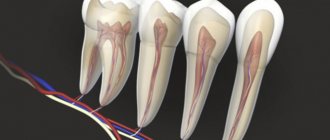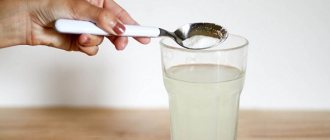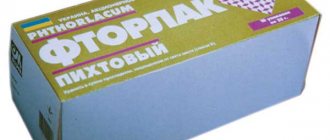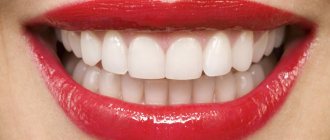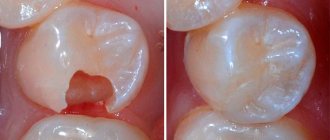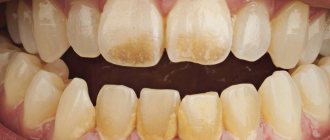All parents go through the period of change of baby teeth in their children. Inept assistance often results in additional problems. The recommendations reflected in this article will help direct the actions of adults in the right direction, without causing the slightest harm to the child’s health.
Read on for information on how to pull out a baby tooth at home, how to do it painlessly, and how they are pulled out in dentistry.
At what point can a baby tooth be pulled out?
An important factor that is taken into account when removing a loose baby tooth is timeliness.
It is quite possible to carry out the procedure at home without visiting a dental clinic. However, before helping your child, read the basic rules :
- As soon as a tooth begins to loosen, it is necessary to regularly promote the separation process that has begun. To do this, you need to recommend that the child swing the connecting rod using his tongue. It is also allowed to perform manipulations with your finger, but first you should wash your hands thoroughly, and after completing the procedure, rinse your mouth with a special lotion.
- If you loosen a tooth with your fingers, do not press on it, as painful sensations may appear.
- If the tooth sits deep in the gums and does not separate from the soft tissues over time, then it is better to consult a dentist.
- It is recommended to talk to the child calmly, without escalating the situation. Children tend to be afraid of everything new; explain that the period of changing teeth happens to every person. If you add fairy-tale fragments to the story about how the mouse must take away the old tooth in order to give it a new one - beautiful and strong, or another interesting story, then it will be easier for the baby to cope with anxiety.
Important! If a tooth is pulled out after a certain period of time, a new one will most likely grow back with signs of deformation.
However, there is no need to rush in such a matter either. Firstly, the process itself will be painful, and secondly, the risk of severe bleeding increases.
Dentist on when to remove baby teeth:
Indications
Among the cases when the doctor may insist that the milk needs to be vomited:
- advanced caries, which can cause infection in the oral cavity;
- cyst;
- a loose element of the dentition injures the gums, which leads to inflammation;
- long-term spontaneous loss;
- chip, crack or other injury;
- orthodontist indications;
- phlegmon;
- periodontitis;
- fistula;
- sinusitis.
If there are such reasons, it is necessary to remove the traumatic element ahead of schedule so that it does not lead to serious diseases of the oral cavity.
Preparatory stage
Feed your baby before the procedure!
As soon as the tooth hangs on a thread-like basis, no pain is felt when loosening to the sides, you can plan the extraction procedure. You should first examine your mouth to make sure there is no inflammation or swelling.
During preparation, it is worth feeding the child, because after the manipulations you should not eat for 2-3 hours.
After this, brush your teeth with paste and brush. You can also use additional rinse aid. All funds used are prepared in advance. They need to be disinfected with high temperature or antiseptic. A set of specific materials is collected depending on the method of tooth extraction used.
Button loops
Today there are several options for how to make a buttonhole:
- Machined loop.
- Hand processed.
- Roll loop.
The simplest option is machine processing. You need to mark the distance according to the size of the button, mark off the entire gap using a machine, and go around the corner a little; the excess thread can be trimmed. It is advisable to use a ripping knife for this.
Manual processing requires more time. The principle of operation is similar, but here a hole of the required size is immediately cut. After this, the edges are sewn with small stitches. The seams must be looped; the craftsman needs to stitch them as close to each other as possible.
How to pull out a tooth in different ways at home
Among the existing methods of removing a child’s tooth at home, the following options are popular.
Using thread
For the procedure, a strong thread (about 50 cm) is selected that can withstand strong tension.
Sequence of manipulations:
- wrap the floss around the base of the tooth (as close to the root as possible);
- sharply pull the ends of the thread in the direction opposite to the jaw (but not to the side!);
- rinse your mouth with an antiseptic.
The end of the thread can also be tied to a door handle; when the door is opened and swung open, the tooth will be removed.
Reference! There is no point in using repeated actions; if the base holds the bone tissue tightly, then the time has not come yet; you should wait a few more days.
Removing a tooth with thread:
Using fingers and gauze
To remove a tooth using gauze, follow these rules :
- cut off a piece of sterile bandage, fold it in half or four times;
- put gauze on the incisor, secure it on both sides with your fingers (you need to wash your hands first!);
- start loosening movements - on the upper jaw, swing in the direction of the lips to the palate and back, on the lower jaw - from the lip to the tongue;
- when the tooth becomes mobile, remove it from the socket;
- Rinse your mouth several times with an antiseptic.
With solid food
This method involves eating raw fruits and vegetables that have a solid structure.
More often the role of provocateur is played by: apple, pear, carrot, cabbage. First, the meaning of the procedure should be explained to the child so that he controls the process and does not eat the tooth along with food. Translational loads on a loose cutter help to separate it from the base.
5 ways to remove a baby tooth:
Rope shackles
It’s very easy to make shackles from rope; all you need is the right pattern and patience. Instructions:
- Make two simple loops that are threaded through each other.
- Hands are threaded inside the two resulting parts.
- Then the remaining part of the rope is tightened. By the way, you can even tighten the loops with your teeth.
In this way you can make loops not only for the arms, but also for the legs.
However, in the event of force majeure, you will not be able to untie them yourself. It is better to experiment if there is a trusted person nearby.
How to minimize pain
In difficult cases, injections are used for anesthesia.
Modern painkillers are effective and safe, they are easily tolerated by young patients. If the child has increased sensitivity to pain, it is advisable to select a suitable anesthesia method for the procedure.
When removing a baby tooth whose root has resolved, it is recommended to use an anesthetic gel . It is first applied to the gum tissue. In more serious cases , when it is necessary to resort to the help of specialists, injectable drugs are used , which are injected into the soft tissue with a very thin needle.
At home, analgin tablet crushed into powder is often used as a pain reliever It is rubbed into the gums with your finger. Such simple anesthesia is quite enough to suppress pain.
Crochet loops
Crocheting is an easy way to create stunning patterns, add variety to your wardrobe and relax after a day of work.
How to make an air loop - insert a hook into an existing loop and throw a thread over it. Next, the master threads the hook with the thread inside. It is advisable not to tighten the loops.
Single crochet - this option is similar to the previous one, you just need to add a few simple steps. The hook is inserted into the hole of the chain or row, then we hook a new loop, and draw the thread into the existing two loops.
Crochet table - the principle is similar, only before threading the hook into the hole, you need to yarn over it. According to this principle, loops are made with two, three, etc. yarn overs.
Loop with hook. This is a great way to make buttonholes unique and durable.
How to make a tooth fall out on your own
You should not insist on manipulation if the child is terrified of it.
You can apply the method without using your fingers or other tools. For example, offer your child to eat an apple or carrot. When biting off pieces of food, there is enough force on the tooth to cause it to fall out on its own. A special loosening of the connecting rod with a finger or tongue can also provoke rapid loss of the cutter.
It is important not to leave the baby alone while eating food; this is necessary to control the process and prevent swallowing of the tooth after it is detached from the base.
Preparing the child
The natural process of changing your bite is usually easy and painless. However, there are times when parental or dental intervention is required. Children are afraid of being hurt, of any outside interference. Therefore, when hesitation is noticed, it is necessary to conduct moral preparation of the child.
It is enough to explain that this is normal. A 5-year-old child will not be able to perceive information correctly, so it is better to use simple figures of speech and a playful form. Mythological children's thinking responds well to all kinds of fairy tales. You can read to your child a special collection of stories dedicated to this phenomenon. Prepare gifts from a fairy-tale character for your patience.
What to do after deletion
Chlorhexidine
After the tooth extraction procedure, you need to rinse your mouth with an antiseptic to prevent infection of the open wound. For these purposes, it is recommended to use Chlorhexidine .
For several days after the manipulations, parents are advised to carefully monitor the baby’s health.
If the temperature rises, swelling or inflammation develops, you should urgently consult a dentist. A reason for a visit to the clinic is also bleeding from the hole.
After tooth extraction at home,
follow these recommendations :
- for 2-3 days after the procedure, you should rinse your mouth with special compounds with an antiseptic effect;
- To brush your teeth, use a brush with soft bristles so as not to damage the open wound;
- exclude sweets, soda and very hot or cold foods from the diet;
- use herbal decoctions with anti-inflammatory effects (chamomile, calendula, sage, etc.) to heal the hole.
The formation of a blood clot in the socket is considered normal, but if the bleeding does not stop within 10-15 minutes, you should consult a doctor. If everything was done correctly, the bleeding can easily be stopped by applying a sterile bandage to the wound.
Oak loop
This is the most reliable loop of all possible options, popularly called a “sea knot”. It is very easy to make, which is why it is very popular among athletes. How to make a loop correctly:
- The rope is folded into two equal parts - end to end.
- The master's hand fixes the bend, after which the part that formed the ring is threaded inside the bend and tightened.
Oddly enough, but this is where the instructions end. Such a knot can be used to secure a vessel or to lift it to a small height.
There is a significant drawback - the size of the loop remains fixed. If you tighten it, it will be quite difficult to untie the knot.
Knowing simple knots in the event of a dangerous situation can even help save lives. It is not necessary to know all the types; it is enough to understand the principle of the simplest loops.
Precautionary measures
When performing tooth extraction procedures on a child at home, important points should be taken into account :
- Do not pull to the side; you can injure soft tissues, provoke extensive bleeding or break off a tooth fragment;
- the incisor located on the upper jaw should be pulled down (on the lower jaw, respectively, upward);
- the oral cavity must be prepared before the procedure, this will reduce the risk of bacteria development;
- a blood clot forms at the site of the removed incisor; it must be washed out by rinsing, and not mechanically;
- As antiseptics, it is allowed to use a solution of potassium permanganate, sea salt, Chlorhexidine;
- all available means (gauze, thread, tweezers, etc.) must be disinfected.
Removing a baby tooth in dentistry:
NAUZ. TIE A THREAD TO AVOID TROUBLES.
The Slavs have always considered nauzes—threads with knots tied around the wrist—to be a strong GUARD against damage and the evil eye.
To make such a talisman, you can use any thread.
The influence and strength of such a bracelet depends on the color.
*Red threads will make you invulnerable: they will protect you from hooligans and unkind people.
*Orange and yellow threads protect against envious people, the evil eye and damage.
*A green bracelet will attract success in money matters and also protect against thieves and deceivers.
*Purple threads will help you avoid dangerous situations and protect you from accidents.
*White threads - facilitates the learning process, makes you inquisitive, develops memory.
*Three woolen threads of different colors on the right wrist will help restore strength and improve health.
*Blue and dark blue impart intuition and the ability to carry on a conversation.
Wear a bracelet made of these threads - it will turn you into a pleasant conversationalist.
The thread should be tied with 7 or 9 knots by a loving person whom you trust:
each nodule is one of the spiritual dimensions + Spells of nodular magic for healing.
Healing:
1.Tie 9 knots on a red thread and wear it around your neck to help heal wounds, illnesses, and headaches.
2.Tie the patient (or yourself) with a red thread. Then untie the knot and throw the thread into the fire, saying:
“I give the disease to the fire; let it be destroyed, as this thread will be destroyed; let it disappear like smoke!”
While the thread is burning, imagine how the disease goes away.
3.Destructive knot spell (unpleasant situation, problem, danger).
Take a thread and visualize the problem, showing your emotions, anger, cry... Then tie a knot. Leave the room and do whatever you can to get everything out of your head. Having calmed down, return to the knot and untie the knot in a peaceful state. See the problem disappear.
kopilohka.ru
When is the use of additional funds justified?
People who wear pullers do not always have confidence that the devices are well fixed and will not fail at the most inopportune moment. Therefore, additional means of fixation are used quite widely. They also have a number of functions:
- at the beginning of wearing they help to adapt to artificial structures in the oral cavity, accelerating addiction,
- prevent particles of food, liquids and air from getting under the prosthesis, ensuring tightness,
- protect the mucous membrane from mechanical irritation, rubbing and subsequent inflammation due to the content of anti-inflammatory components,
- when using products with refreshing ingredients (not all have them), they give freshness to your breath,
- prevent the structures from moving and falling out during long-term use if the position of the gums changes.
However, it is important to remember that additional means of fixation in case of long-term use of the structure do not replace a trip to an orthopedist for its relocation, repair or replacement with a new one. Their use is justified with high-quality structures for additional stability in the oral cavity.
1Samusenkov V.O. [and others] Rational approaches to prosthetic treatment of patients with diseases of the oral mucosa / Dentistry for everyone. – 2014. 2Zholudev S.E. Features of prosthetics with complete removable dentures and adaptation to them in elderly and senile people / Ural Medical Journal. – 2012.
Author: Dulgarov Zh. G. (Thank you for your help in writing the article and the information provided)
What affects the quality of fixation of dentures in the oral cavity?
No matter how high-quality the removable appliance is initially, its functionality after installation is measured by the comfort of wearing for the patient and the ability to replace lost teeth as much as possible, restore chewing function and aesthetics of the row.
PROSTHETICS WITH 6 OSSTEM IMPLANTS FROM RUB 200,000.
Complex implantation Osstem (South Korea) with delayed loading after 4-6 months.
Call now or request a call
What affects the fixation of dentures? There are factors that influence the fixation and position of artificial devices in the oral cavity, which must be taken into account when creating a design:
- anatomical features (“relief”) of the alveolar ridge, palate and prosthetic bed. The vertical shape of the gums is more conducive to retaining the structure than flat, mushroom-shaped or sharp ones.
- interaction of the apparatus when chewing with the inside of the cheeks, lips, their holding ability or, conversely, the possibility of displacement during muscle movement,
- the position, size and mobility of the tongue, under which a bed is formed in mandibular complete dentures. The tongue can also both hold the structure in place and move it,
- uniform distribution of load on the bed,
- absence of pre-contacts: the teeth of one side of the device should not come into contact with the opposite ones before the other side. In this case, the device cannot tip over,
- correct position of artificial teeth along the axis.
The quality of fixation and stabilization of removable dentures determines the effectiveness of orthopedic treatment1. Experts evaluate the quality of fixation using the Ulitovsky-Leontiev index, which describes more than 10 fastening parameters.
